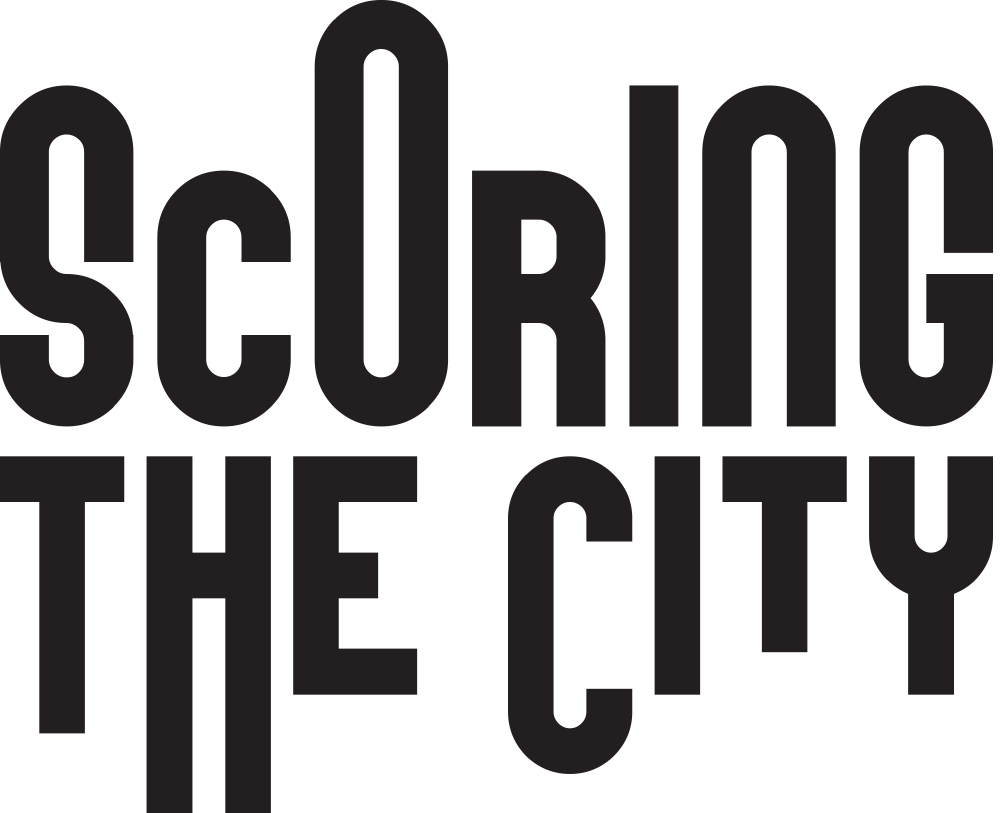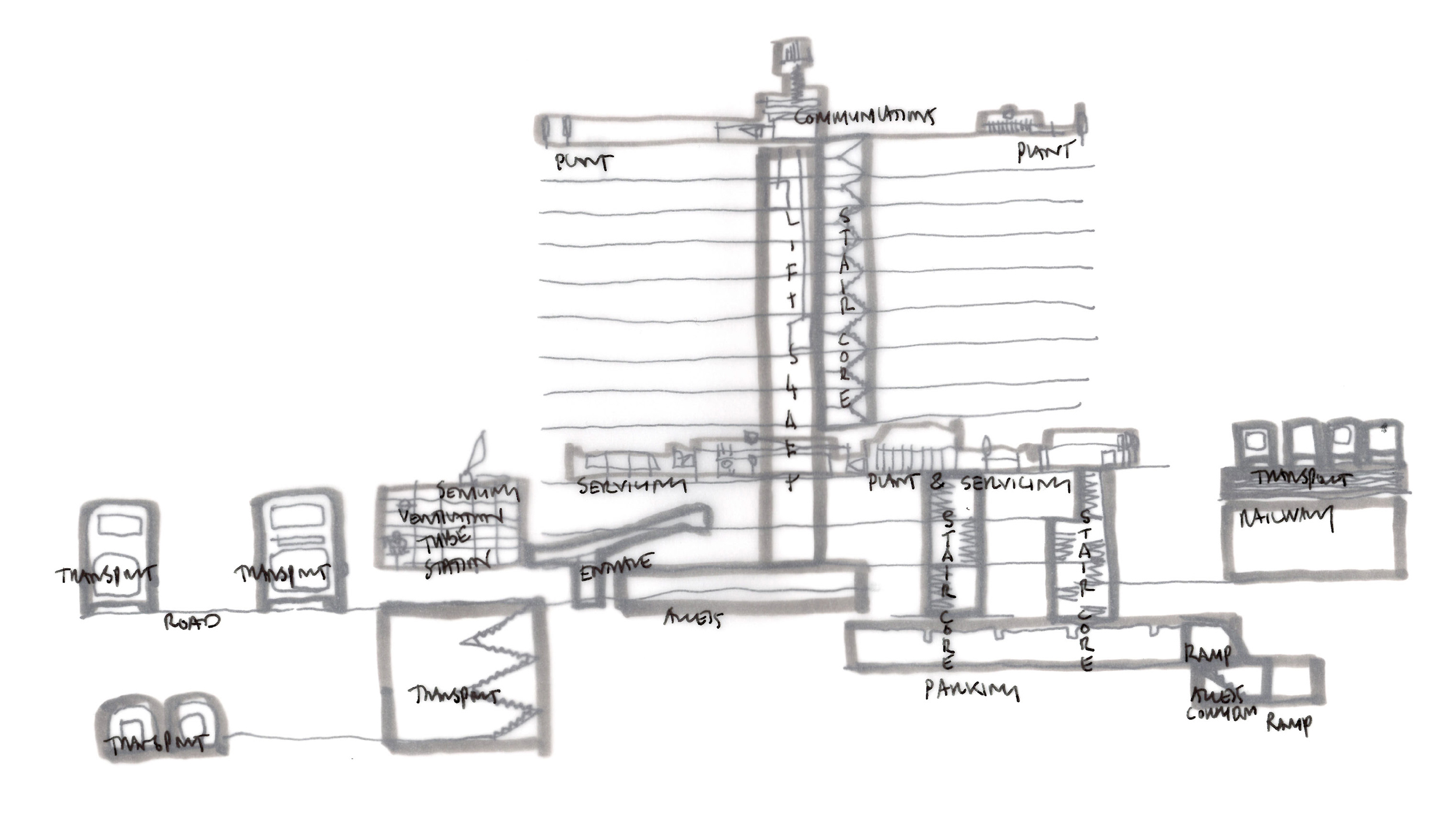by Fani Kostourou
Richard Sennett, in his book Building and Dwelling, elaborates on ‘Five Open Forms’ that do – and should – characterise the design of cities based on people’s spatial and sensorial experiences. He argues that open forms can be characterised in five key ways: they are synchronous, punctuated, porous, incomplete, and multiple. They are synchronous because they allow for many different activities in one space at the same time. They are punctuated in order to gain distinctiveness and to provide orientation. They consist of porous yet high-intensity edges that serve as social spaces and sites of interaction between different groups. As incomplete forms, they are also able to change and grow over time as a result of bottom-up processes. And, last, they are comprised of multiple, equally open, elements at different scales, each of which contributes to the formation of a larger more complex, multi-layered, and dynamic urban whole.
While Sennett argues for these principles to achieve more open and less (over)planned cities, the Scoring the City project sought to explore further the ways in which we can encode these principles in architectural drawings and urban plans, and what it would mean for architecture to embrace collective improvisation, play, and other conditions which can be found in some musical cultures. As Gascia Ouzounian asks in her essay, “what might architecture and urban design look like if its notations—for example, blueprints and plans—were not fixed forms, but rather open, unstable, and dynamic?” In other words, open scores that map out possibilities for more volatile, animated and unplanned spaces in cities.
In what follows, I expand on Sennett’s suggestions for open forms in cities and enunciate a series of provocations regarding how the above can be translated into open scores for cities. The provocations serve as ideas-to-think-with when revisiting some of the early sketches of the participants and while reimagining the urban.
Provocation 1: In a space, people do many different activities at the same time. But activities also unfold sequentially. How many truly different activities should be mixed in a synchronous space? For how long should sequences be scored?
Here we can be inspired by musical concertos (Italian word meaning accord or gathering) which involve the synchronous and sequential combination and interaction of independent voices and instruments. Similarly, in cities, multiple voices, activities, interactions and routes are performed at the same time or one after the other, always responding to the existing infrastructure and urban form as well as to people’s actions and behaviours. Yet architectural blueprints that dictate the planning of urban spaces rarely depict these different dynamics synchronically or sequentially.
‘There is more infrastructure than you might think’. Sketch score for Elephant & Castle shopping centre by Oliver Goodhall for the Scoring London workshop.
In the Scoring London workshop, architect Oliver Goodhall noticed that, so much of the infrastructure needed to support the city’s activity is lost when simply depicted in plan view. When understood as a blueprint or coded from a bird’s eye view, this detail is flattened. This is why his sketch-score illustrates a section that cuts through a block at Elephant & Castle, seeking to highlight some of the infrastructures needed to make the floors of workspace operate; transport, communications, access and servicing to name just a few. The score helps unveil all the activities that happen synchronously at the backstage of the built environment.
Provocation 2: Space needs to be punctuated to be distinctive, to provide orientation, and to invite people to mix and perform their activities on the ground and through time. How to punctuate space? Does it need to be punctuated and what is it used for?
Punctuation in music is rather characteristic, even to unfamiliar audiences. Scores operate as a canvas that organises symbols and marks to convey intention and provide guidance for different sonic experiences. They might feature any number of elements, including: text, including structural markers (‘A’, ‘B’, ‘C’, etc.); short instructions to indicate tempo or dynamics (allegro,lento, forte, pianissimo); elaborate instructions; symbols (i.e. staff lines, articulation markings, ornaments, notes and rhythms) or groups of symbols representing recurring patterns or set forms; numbers or tablatures for positioning the fingers on an instrument; and colours in order to give meaning and intuitive information about sounds.

‘Subterranean Infrastructural Palimpsest’. Sketch score for Elephant & Castle shopping centre by Matt Parker for the Scoring London workshop.
In the Scoring London workshop, sonospheric investigator Matt Parker focused on the multi-coloured markings made on the roads and pavements of the Elephant & Castle shopping centre placed by engineers to demarcate subterranean network infrastructure. The markings, according to him, were directing the movements and other sounding and unsounding gestures, and his sketch-score was an attempt to convey that meaning: one must move as subterranean network infrastructure, palimpsestuously.
Sennett uses the metaphor of punctuation from writing and provides the examples of the exclamation mark, the quote marks, and the semicolon. If we are to continue his thinking process and find possible analogies in the music, then we would be able to imagine the following:
The exclamation mark (!) can be paralleled to dynamics, pianissimo, forte, sforzando etc. that denote intensity. In an open score for an urban site, we would therefore ask, what kind of dynamics does the site mean to offer – is it soft/quiet/flat-line or loud/sharp/sonically intelligible? What is its role in the wider city score – impactful and orientation or amplifier and inclusion?
Quote marks ( ‘ ’ ) can be compared to accidentals, like sharp, flat or natural symbols, which modify the pitch of a note and allow for deviations from the norm, overriding the instructions (key signature) provided at the beginning. Equally, this punctuation in an urban score would represent the role of a space in the city and the possibility to change its prescribed and planned function during or after its use. Does the site function as a signifier or a gesture in the wider area? Will it continue to mark an arbitrary, important, or problematic spatial form? What can affect the site’s intended function and how?
The semicolon (;) could be equivalent to rests, which indicate the absence of sounds. Accordingly, these signs would mark moments of pause and reflection in the sonic urban experience. Where can these spaces be found and in what frequency should they be introduced? How can the transition between these and the louder and more formal spaces be mediated?
In the same workshop, contemporary music composer Jonathan Packham used punctuation as a means of coordination between two performers who play or sing a unique gesture repeatedly. At each circular node, they are asked to listen to their partner and change their own gesture’s pitch or intensity according to what they hear. Through a continuous active loop of accommodation between self and other, the sketch articulated a conflict between individual listening (in that comprehension of your partner’s sonic utterance is subjective) and co-dependency. In this case, punctuation denoted performers’ agency to negotiate and change their spatial gestures as they play along.
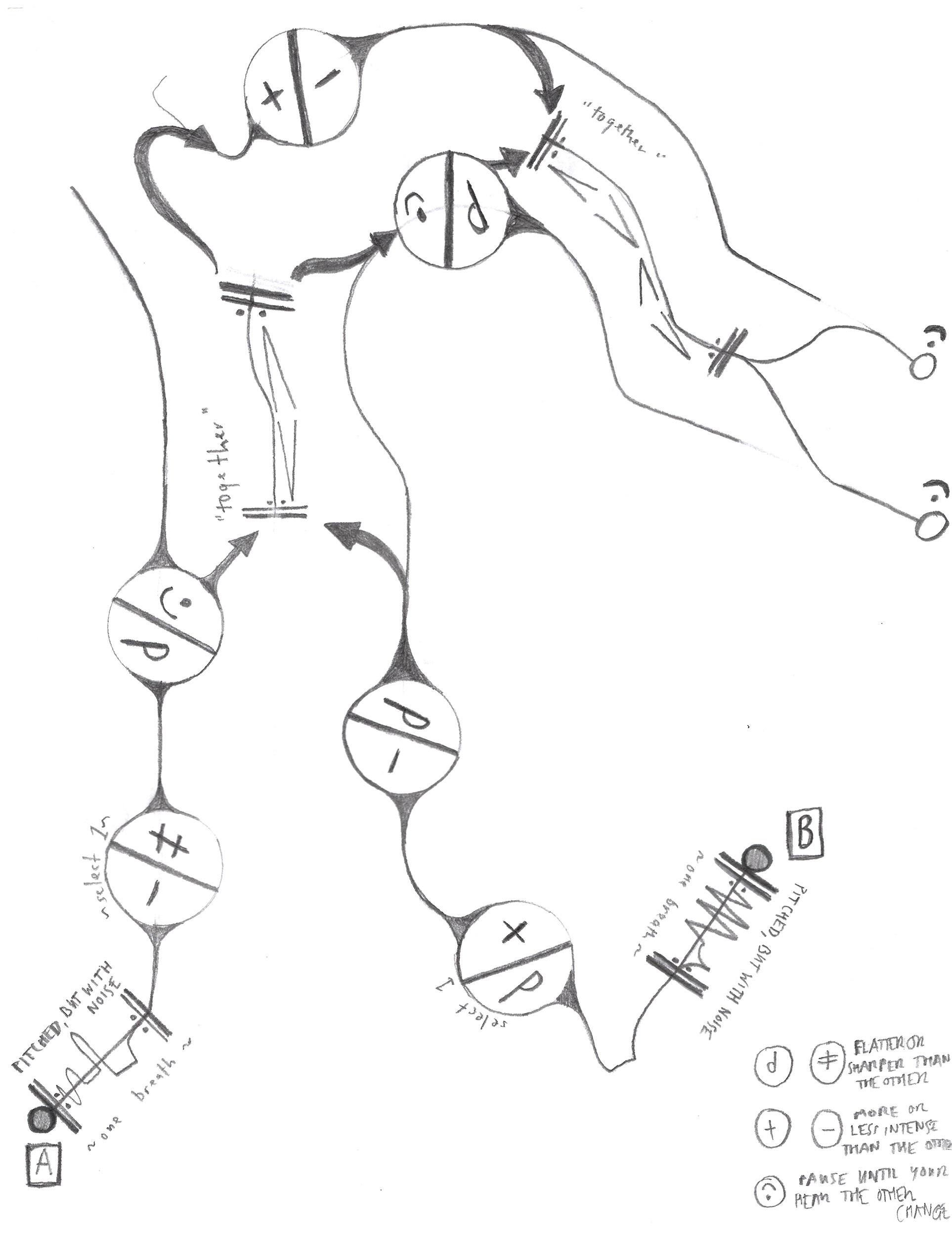
‘For Two Performers’. Sketch score for Elephant & Castle shopping centre by Jonathan Packham for the Scoring London workshop.
The piece also took its graphic cue from the plan of the iconic roundabout in Elephant & Castle neighbourhood, playing on the way that multiple human and vehicular sonic paths are condensed into swirling spaces that feed off a new public life back in the city. In cities, roundabouts can serve as social spaces and sites of exchange and transition; and the same goes for other types of borders, as Sennett suggests.
Provocation 3: Borders are porous, high-intensity edges where different groups interact. As it happens in nature, they represent liminal spaces where life becomes more interactive due to the meeting of different species and physical conditions. To allow that interaction, they are neither totally sealed nor totally exposed. Boundaries are not for they mean to exclude by establishing closure.
When a double bar line appears in a musical score, it indicates the end of a piece or movement and the beginning of a new section with new rules, sets of symbols and marks, and time signature. While being two distinct parts of the same composition, the bordering of the two signifies a connection or sometimes an intentional disruption, which may transform the performer’s and the listener’s experience. Similarly, our experience passing through the city is characterised by a constant – if not blocked – crossing of borders and borderlands between different socio-spatial systems. Joan Baz, a graphic designer and artist who participated in the Scoring Beirut workshop, sought to visually record this constant transitioning by mapping the spatial sounds that she was hearing as she was walking through Achrafieh.

‘Spaces in-between’. Sketch score for the streets around Achrafieh and Sassine square by Joan Baz for the Scoring Beirut workshop.
However, it is often hard to make the distinction between borders and boundaries in a city (and its planning), which in turn amplifies the tension between its centre and edges. Where do borders become conscious and present in this urban transect? How can their interaction be (re)scored? The site of Scoring Paris workshop was the disused and largely inaccessible railway depot of Chapelle Charbon located at the northern edge of Paris, just within the boulevard Périphérique. Seen more as a gated boundary than a porous border, the municipality is currently redeveloping it into a major park for the public. In his sketch, musician and urbanist John Bingham-Hall scored the process of the site’s rehabilitation and edge perforation through the participation and performative involvement of the local community. He argued that in this process physical edges become concentrating rather than excluding.

Untitled for a new field of public life focused on the park but expanding into surroundings. Sketch score for Chapelle Charbon by John Bingham-Hall for the Scoring Paris workshop.
Provocation 4: Incomplete forms are able to change and grow over time involving people in the process. A basic set of rules can allow for more variations at any given moment.
Improvisation is a defining element in jazz. It challenges the performer to create on-the-spot and spontaneously invent new melodic and harmonic variations and embellishments over existing chord progressions. No two improvisations are or sound the same. Yet, this process of individuation reveals two things: first, that a bare minimum infrastructure can allow for a variety of formal outcomes and second, that a shared set of rules ensures unity – rather than uniformity – in the end result. The same applies for an architectural design for cities. Which are the minimum relationships that need to be defined to allow for variations? Is the score a type-form or a prototype – does it set the terms for making a family of possible objects or is it a specific demonstration of what can be done?
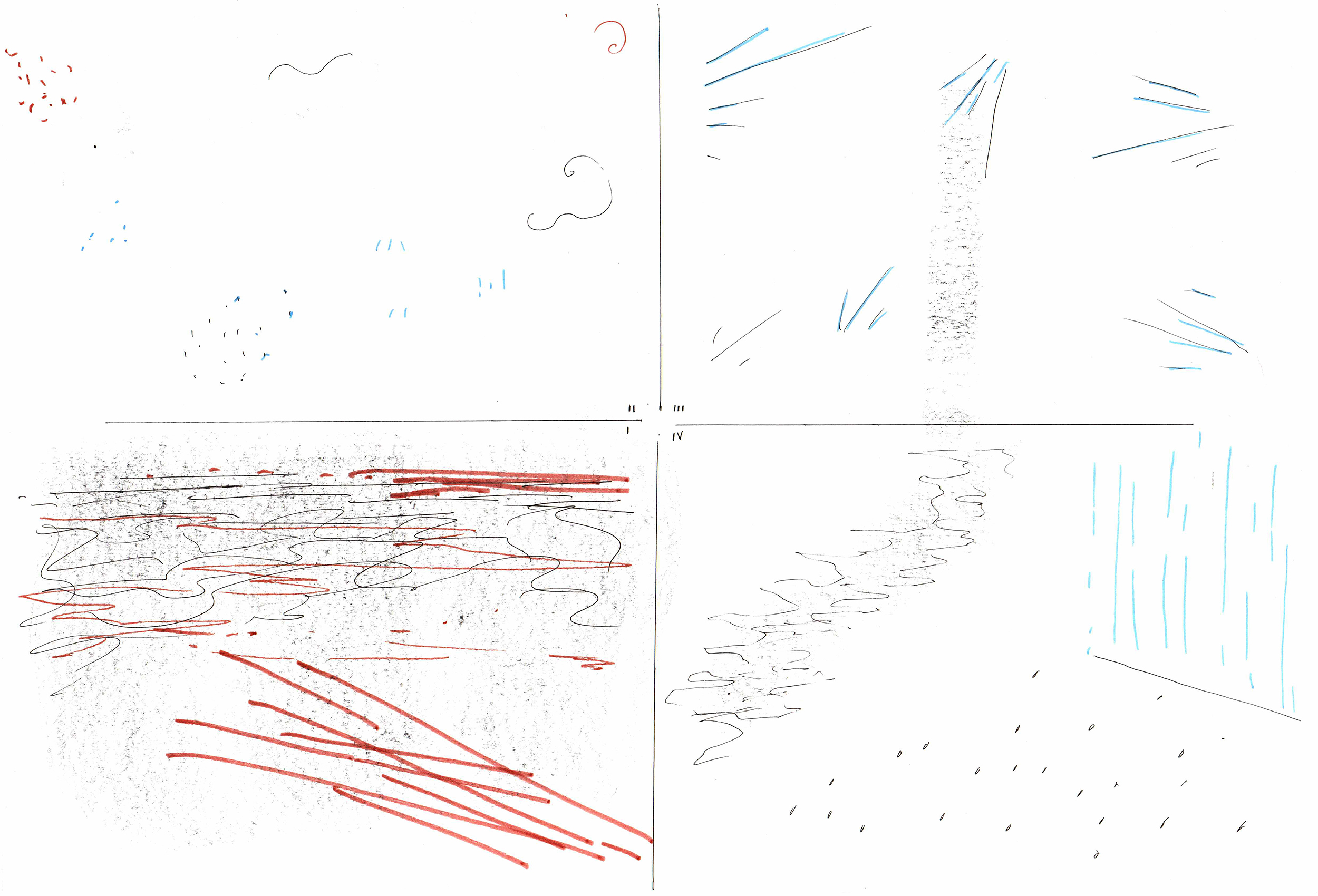
‘Four scenes in Sailortown: I. Soundful construction II. Quiet anticipation III. Interior voices IV. Mixed horizons.’ Sketch score for Sailortown by Elen Flügge for the Scoring Belfast workshop.
In the piecemeal regeneration of Sailortown in Belfast, Elen Flügge noticed the different atmospheres of its incomplete forms. The musician and urban sound researcher wrote, “As I walked toward the Harbor Commissioners office I was impressed by the physical and sonic presence of the motorway flyover. Later, several aspects of the tour with Terry [McKeown] struck me. First we looked from the tidily revamped path along the river, over to the waterfront regenerations on the opposite bank. On this side a new addition included a multi-story car park. Then we stood in the square of The Rotterdam hearing about the pubs, use of the space for music, noise complaints and the presence of tall buildings behind. The square seemed particularly quiet, as the sound of the motorway was blocked by other buildings, and trees added to a calmer atmosphere. Inside the bare-stripped church Terry’s voice resonated sharply as she talked about how the community was scattered and how that affected families and neighbors – the ones you might have had around to help out or watch over children.” Flügge’s sketch-score captured the sequence of her audio-visual impressions from a neighbourhood that is in the process of physical and social change.
Provocation 5: Open elements are seeds planned to form a complex, multi-layered, dynamic, and porous urban collage. They each inherit the properties of the larger and more global open form and benefit from the unexpected configurational opportunities created between multiple elements at the local scale—a condition which is specific to the context. Even if we insert the same building in two different urban settings, the way they will influence and be influenced by their surroundings will differ. So how does one building or site fits within the collage of the neighbourhood and that of the city? Is the sum of the scored parts greater than the whole or not? This question was addressed by lecturer and urban researcher Timothy Pape in the Scoring London workshop. His sketch-score sought to map the everyday practices inside the Elephant & Castle shopping centre and demonstrate how the actual building-scape becomes augmented by a myriad of individual and open potentialities.
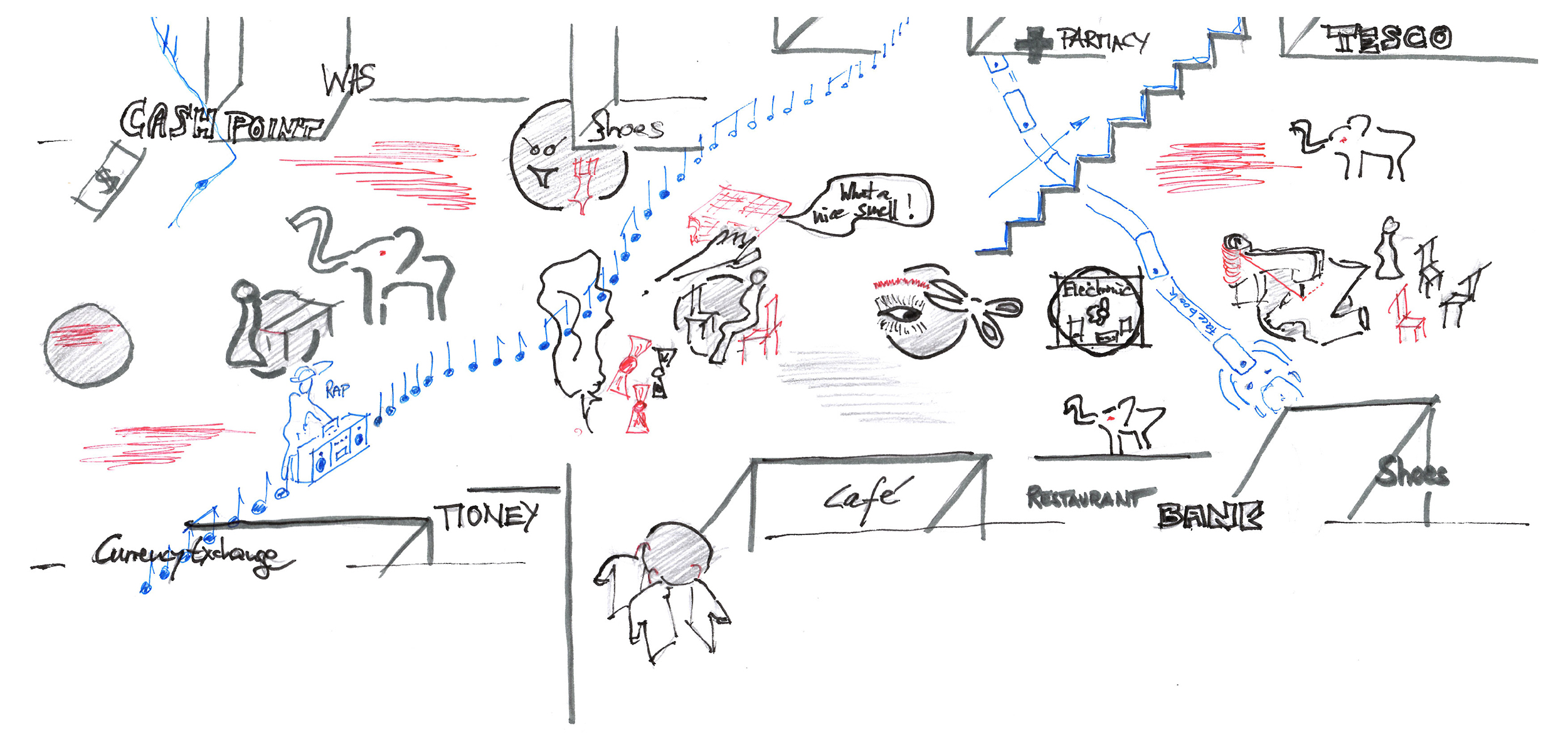
Untitled. Sketch score for Elephant & Castle shopping centre by Timothy Pape for the Scoring London workshop.
At the end, these provocations are a call for architects, planners, and city-makers to reconsider, while being inspired by musical cultures, how cities can be designed in the future. No concrete answers, design tips or techniques are provided. Instead, both the translation of the five open forms into open scores – and the scores themselves in this website – need to be seen as non-prescriptive and interpretative. Open scores for open forms.
References
Sennett, R., 2018. Building and dwelling: ethics for the city. Farrar, Straus and Giroux.
Ouzounian, G. 2020. ‘Scoring the City: Musical, Architectural, and Urban Notations’. Scoring the City. http://scoring.city/library/essays/scoring-the-city-musical-architectural-and-urban-notations/
